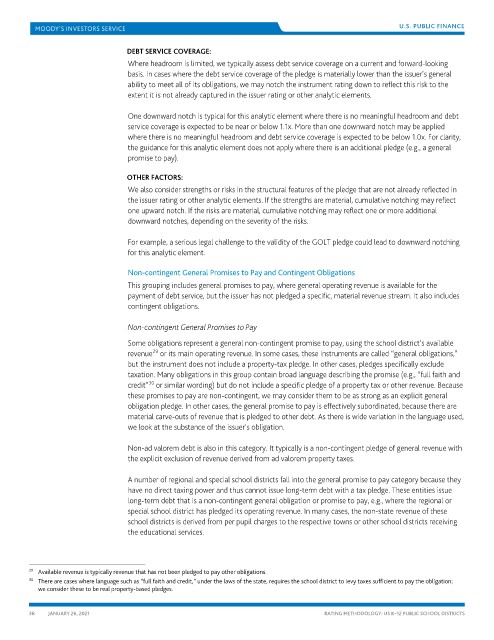Page 1677 - draft
P. 1677
U.S. PUBLIC FINANCE
DEBT SERVICE COVERAGE:
Where headroom is limited, we typically assess debt service coverage on a current and forward-looking
basis. In cases where the debt service coverage of the pledge is materially lower than the issuer’s general
ability to meet all of its obligations, we may notch the instrument rating down to reflect this risk to the
extent it is not already captured in the issuer rating or other analytic elements.
One downward notch is typical for this analytic element where there is no meaningful headroom and debt
service coverage is expected to be near or below 1.1x. More than one downward notch may be applied
where there is no meaningful headroom and debt service coverage is expected to be below 1.0x. For clarity,
the guidance for this analytic element does not apply where there is an additional pledge (e.g., a general
promise to pay).
OTHER FACTORS:
We also consider strengths or risks in the structural features of the pledge that are not already reflected in
the issuer rating or other analytic elements. If the strengths are material, cumulative notching may reflect
one upward notch. If the risks are material, cumulative notching may reflect one or more additional
downward notches, depending on the severity of the risks.
For example, a serious legal challenge to the validity of the GOLT pledge could lead to downward notching
for this analytic element.
Non-contingent General Promises to Pay and Contingent Obligations
This grouping includes general promises to pay, where general operating revenue is available for the
payment of debt service, but the issuer has not pledged a specific, material revenue stream. It also includes
contingent obligations.
Non-contingent General Promises to Pay
Some obligations represent a general non-contingent promise to pay, using the school district’s available
29
revenue or its main operating revenue. In some cases, these instruments are called “general obligations,”
but the instrument does not include a property-tax pledge. In other cases, pledges specifically exclude
taxation. Many obligations in this group contain broad language describing the promise (e.g., “full faith and
credit” or similar wording) but do not include a specific pledge of a property tax or other revenue. Because
30
these promises to pay are non-contingent, we may consider them to be as strong as an explicit general
obligation pledge. In other cases, the general promise to pay is effectively subordinated, because there are
material carve-outs of revenue that is pledged to other debt. As there is wide variation in the language used,
we look at the substance of the issuer’s obligation.
Non-ad valorem debt is also in this category. It typically is a non-contingent pledge of general revenue with
the explicit exclusion of revenue derived from ad valorem property taxes.
A number of regional and special school districts fall into the general promise to pay category because they
have no direct taxing power and thus cannot issue long-term debt with a tax pledge. These entities issue
long-term debt that is a non-contingent general obligation or promise to pay, e.g., where the regional or
special school district has pledged its operating revenue. In many cases, the non-state revenue of these
school districts is derived from per pupil charges to the respective towns or other school districts receiving
the educational services.
29 Available revenue is typically revenue that has not been pledged to pay other obligations.
30 There are cases where language such as “full faith and credit,” under the laws of the state, requires the school district to levy taxes sufficient to pay the obligation;
we consider these to be real property-based pledges.
38 JANUARY 26, 2021 RATING METHODOLOGY: US K–12 PUBLIC SCHOOL DISTRICTS

